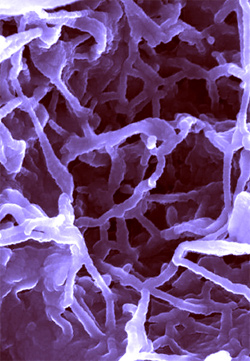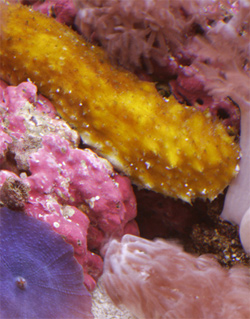Biomimicry of sea cucumber skin may help stroke treatment
Biomimicry of sea cucumber skin may help stroke treatment
mongabay.com
March 6, 2008
|
|
Using sea cucumber skin for design inspiration, scientists have developed a new material that may improve treatment for Parkinson’s disease, stroke and spinal chord injuries. The research is published in the journal Science.
The material, which like the skin of the sea cucumber can switch between rigid and flexible states, may someday be used in biomedical implants “as a protective sheath around brain microelectrodes, which would be stiff when implanted but could then become flexible, reducing the impact on surrounding tissue,” according to AAAS, publisher of Science.
“Jeffrey Capadona and colleagues added cellulose nanofibers, or ‘whiskers’, to a rubbery copolymer mixture,” the AAAS release continued. “When they added a solvent that caused hydrogen bonding, the solvent disrupted the bonding between the fibers, thus softening the material. When the solvent evaporated, a network between the whiskers could reform, thus stiffening the material. The authors used cellulose whiskers from the mantles of sessile sea creatures known as tunicates but they say that renewable sources like wood and cotton could be sources for similar nanofibers.”
 Scanning electron microscopy images of a bio-inspired stimuli-responsive polymer nanocomposite with adaptive mechanical properties. Image courtesy of Case Western Reserve University  Sea cucumbers inspired the design of stimuli-responsive polymer nanocomposites with adaptive mechanical properties. Image courtesy of Fred Carpenter |
“We can engineer these new polymers to change their mechanical properties — in particular stiffness and strength — in a programmed fashion when exposed to a specific chemical,” said co-author Christoph Weder of Case Western Reserve University (CWRU).
“The materials on which we reported in Science were designed to change from a hard plastic — think of a CD case — to a soft rubber when brought in contact with water,” added Stuart Rowan, a researcher at the Louis Stokes Cleveland Department of Veterans Affairs Medical Center’s Advanced Platform Technology (APT) Center.
“Our new materials were tailored to respond specifically to water and to exhibit minimal swelling, so they don’t soak up water like a sponge,” said CWRU graduate student Kadhiravan Shanmuganathan.
The researchers said the sea cucumber was their model.
“These creatures can reversibly and quickly change the stiffness of their skin. Normally it is very soft, but, for example, in response to a threat, the animal can activate its ‘body armor’ by hardening its skin,” said Capadona, lead author and associate investigator at APT.
Biomimicry, also called biomimetics, describes design inspired by nature.